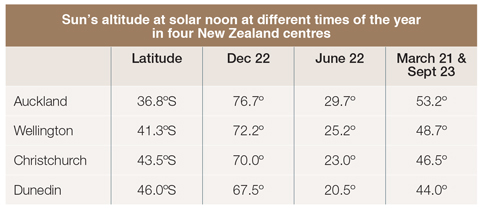Site Analysis
Understanding all the features of a site, using and protecting the best, and minimising the impact of the worst.
Sun
By analysing the impact of the sun on a site, as well as the building’s location, the spatial arrangement, orientation, window placement, daylight access and other design features, the designer can take full advantage of passive solar design features and increase the energy efficiency, comfort and financial value of the building.
On this page:
- assessing a site for sun
- Sun paths
- altitude and azimuth
- solar radiation
- building material durability
- shade
- sites with limited solar access
- sunlight adds dollar value to a house
- locating information.
Assessing a site for sun
When assessing a site for sun, consider:
- the time during the day that the site receives sunlight
- the sun's path at different times of the day and year
- how the site’s shape, slope and orientation affect solar access
- how obstructions such as adjacent buildings, trees and landforms will impact on the site and the potential design
- the owners' lifestyle – for example, when they want to have sun or shade.
Ideally a site should have excellent solar access for most of the day and be of a shape/size to allow a home to be built with the living areas facing north, requiring minimal purchased energy for space heating. By contrast, a house on a site that sees little sun, or where living areas cannot face north, will typically require higher amounts of purchased energy, and therefore have a bigger carbon footprint.
Sun paths
Assessing the passage of sun across a site is important. There are a number of locally-produced tools that can help, but a site visit is still necessary to identify site-specific conditions such as the impact of a large tree.
Sun path diagrams provide a broader overview of sun on a site as they map the path of the sun across the sky at different times during the day throughout the year. They can help establish the position of the sun relative to a site and can be used to determine the effect of shadows cast by buildings, trees and landforms on and around the site.
NIWA’s online tool SolarView can provide information quickly and accurately. However, it only accounts for geographic (land) features. Foliage and fences may also need to be considered. Be aware that if the site is shaded for more than 40% of the time compared to a clear site, then this has significant implications for the thermal performance of the house.
SketchUp’s shading feature can also help with establishing shadow length.
Altitude and azimuth
The position of the sun with respect to an observer is commonly represented by two angles – altitude and azimuth.
Altitude is the angle of the sun’s rays compared with the horizon. At sunrise and sunset, the altitude is zero, and in the southern hemisphere, the maximum altitude of the sun at any specific location occurs at solar noon on 21/22 December (longest days of the year).
Azimuth (sometimes known as bearing) is the direction of the sun as shown on a compass. Sun bearings at sunrise and sunset at different New Zealand latitudes are available from Land Information NZ’s astronomical information.
Solar radiation
Solar or ultraviolet (UV) radiation is the energy from the sun. The amount of solar radiation available on a site depends on the latitude and the sunlight hours received.
Information about UV levels can be obtained from NIWA’s UV Atlas which provides information about UV levels around New Zealand since 1960.
BRANZ also has a photovoltaic generation calculator that indicates the average yearly electricity generation capability of a PV system at a given location.
Building material durability
UV radiation affects the durability of many materials. Colours fade, plastic-based materials may become brittle, timber moves and twists, and expansion and contraction from heating and cooling places stress on many materials, so the effect of UV radiation over a building’s lifetime must be considered.
Materials such as paint on the north or west side of a building may not last as long as those on the south side because the north and west sides receive much more UV light. BRANZ found that for a test building in Wellington, the daily average UVA irradiation on the north wall was approximately 6 times higher than that on the south wall.
Select materials with a higher UV index number (when available) as they are more resistant to UV degradation (such as fading).
Shade
Shade is often required in the summer, but in most parts of the country, winter sun is desirable. Obstructions on a site may block sunlight access at times when it is required.
When considering sunlight and building design, assess the impact of obstructions in the future as well as the present. For example, a small tree on an adjacent site may grow into a large one that blocks sun, a building may be erected on a currently vacant site or an existing building may be demolished and replaced by a larger one.
Alternatively, existing trees may be retained for summer shade.
Sites with limited solar access
South and east-facing, sloping sites have limited solar access. It is difficult to utilise effective passive solar design features on these sites, and they should generally be avoided. Where it is not possible to avoid or the site is an otherwise desirable one (e.g. if it has excellent views), careful consideration of design including building location (e.g. locate as high as possible on the site), orientation and use of skylights/clerestories can maximise the benefits of solar access. Specifying higher-performing thermal insulation than the minimum levels required is also recommended.
Sunlight adds dollar value to a house
A New Zealand study by Motu Economic and Public Policy Research Trust, Valuing Sunshine, looked at the value buyers place on the amount of sunshine houses receive. They found that each additional hour of direct sunlight exposure for a house per day, averaged across the year, added 2.4% to its market value.
Locating information
The National Institute of Water and Atmospheric Research (NIWA) provides climate station data for its 30 climate stations throughout New Zealand, including information about sunshine hours and mean temperatures.
Aerial photographs can provide information about the b/n adjacent sites and may provide some limited information about the impact of sun on a site. This will depend on the age of the photo as in older photos, trees may have grown. Aerial images can be obtained from local councils, Google Earth and Terranet.
Sun impact information is also available:
- by carrying out an on-site survey to establish levels of adjacent buildings and site features.
- obtaining plans of neighbouring buildings from local councils.
Updated: 11 March 2021


